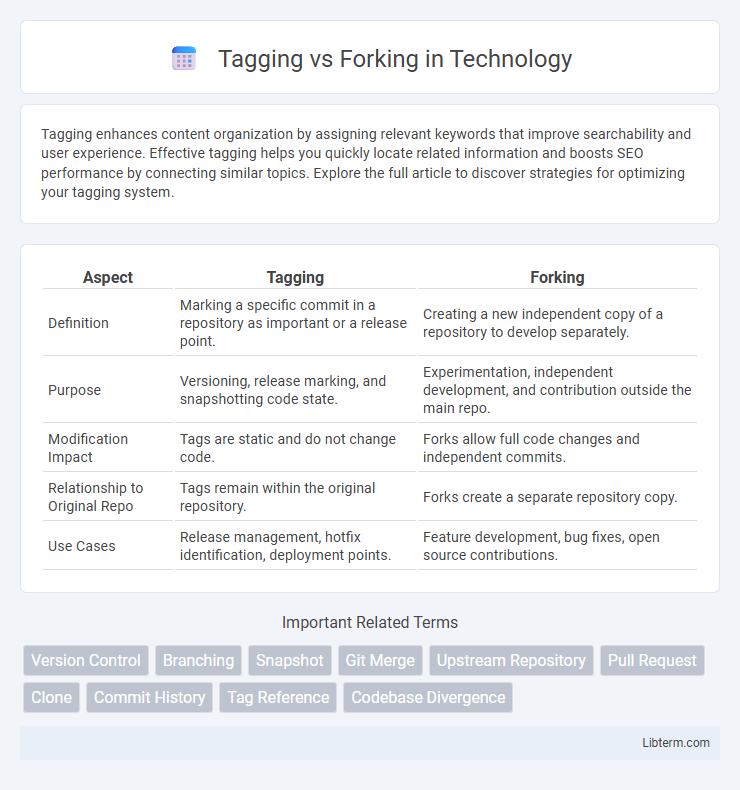Tagging enhances content organization by assigning relevant keywords that improve searchability and user experience. Effective tagging helps you quickly locate related information and boosts SEO performance by connecting similar topics. Explore the full article to discover strategies for optimizing your tagging system.
Table of Comparison
| Aspect | Tagging | Forking |
|---|---|---|
| Definition | Marking a specific commit in a repository as important or a release point. | Creating a new independent copy of a repository to develop separately. |
| Purpose | Versioning, release marking, and snapshotting code state. | Experimentation, independent development, and contribution outside the main repo. |
| Modification Impact | Tags are static and do not change code. | Forks allow full code changes and independent commits. |
| Relationship to Original Repo | Tags remain within the original repository. | Forks create a separate repository copy. |
| Use Cases | Release management, hotfix identification, deployment points. | Feature development, bug fixes, open source contributions. |
Introduction to Tagging and Forking
Tagging in version control systems involves creating a specific snapshot of the codebase at a particular point, often used for releases or milestones, ensuring stable reference points for development and deployment. Forking creates an independent copy of a repository, allowing developers to experiment or customize code without affecting the original project, facilitating collaborative and decentralized development. Both practices optimize workflow by managing code versions and enabling parallel progress in software projects.
Definitions: What is Tagging?
Tagging is a version control practice that involves assigning a specific identifier, or tag, to a particular commit in a repository to mark a significant point, such as a release or milestone. Tags are immutable references that help developers easily locate and share specific states of the codebase without altering its history. Unlike branches, tagging does not create a new line of development but serves as a snapshot for future reference in tools like Git.
Definitions: What is Forking?
Forking is the process of creating a personal copy of someone else's repository, allowing independent development and modifications without affecting the original codebase. It enables developers to experiment, contribute, or customize projects while maintaining a separate version history. Forking is essential in collaborative platforms like GitHub for managing open-source contributions and creating divergent project variations.
Key Differences Between Tagging and Forking
Tagging creates a snapshot of a specific point in a repository's history, enabling users to mark releases or milestones without altering the codebase. Forking generates a complete copy of a repository, allowing independent development and modifications separate from the original project. Key differences include tagging's focus on version identification and forking's role in facilitating collaborative development through isolated code changes.
Use Cases for Tagging in Version Control
Tagging in version control is primarily used to mark specific points in a repository's history as important, such as release versions, stable builds, or milestones, ensuring easy reference and deployment. It enables teams to create fixed snapshots without affecting ongoing development, which is critical for continuous integration, rollback scenarios, and software releases. Tags provide a lightweight, immutable identifier for committed states, facilitating version tracking and auditability across collaborative workflows.
Use Cases for Forking in Version Control
Forking in version control enables developers to create independent copies of a repository, facilitating experimentation without affecting the original project. It is ideal for open-source contributions where multiple collaborators work on distinct features or bug fixes before merging changes via pull requests. Forking supports parallel development and comprehensive code review workflows, ensuring controlled integration and maintaining codebase stability.
Advantages of Tagging
Tagging offers the advantage of creating lightweight, immutable markers that efficiently capture a specific state in a repository without duplicating the entire project history, facilitating easy reference and release management. Tags help maintain a clear and organized versioning system, enabling teams to quickly identify stable or significant points in the development lifecycle. Unlike forking, tagging preserves the continuity of the main project, supporting streamlined collaboration and reducing overhead in version control workflows.
Advantages of Forking
Forking offers significant advantages in open-source development, such as creating an independent copy of a repository that enables unrestricted experimentation and innovation without affecting the original project. It empowers developers to introduce substantial changes, develop new features, or fix bugs while maintaining a clear project history and facilitating easier collaboration through pull requests. This autonomy and flexibility accelerate development cycles and enhance project diversification across GitHub and other platforms.
Choosing Between Tagging and Forking
Choosing between tagging and forking depends on the project's collaboration needs and version control strategy. Tagging is optimal for marking specific points in a repository's history, such as releases, without creating new code branches, enhancing clarity in version tracking. Forking creates a separate copy of the repository, ideal for independent development and contribution workflows, particularly in open-source projects requiring isolated testing and feature enhancement.
Best Practices for Effective Version Control
Tagging provides a lightweight method to mark specific points in a repository's history, ideal for release versions and stable updates. Forking creates an independent copy of the entire project, enabling parallel development and experimentation without affecting the original codebase. Best practices recommend using tags for version identification and forks for collaborative feature development, ensuring clear project organization and efficient version control workflows.
Tagging Infographic

 libterm.com
libterm.com